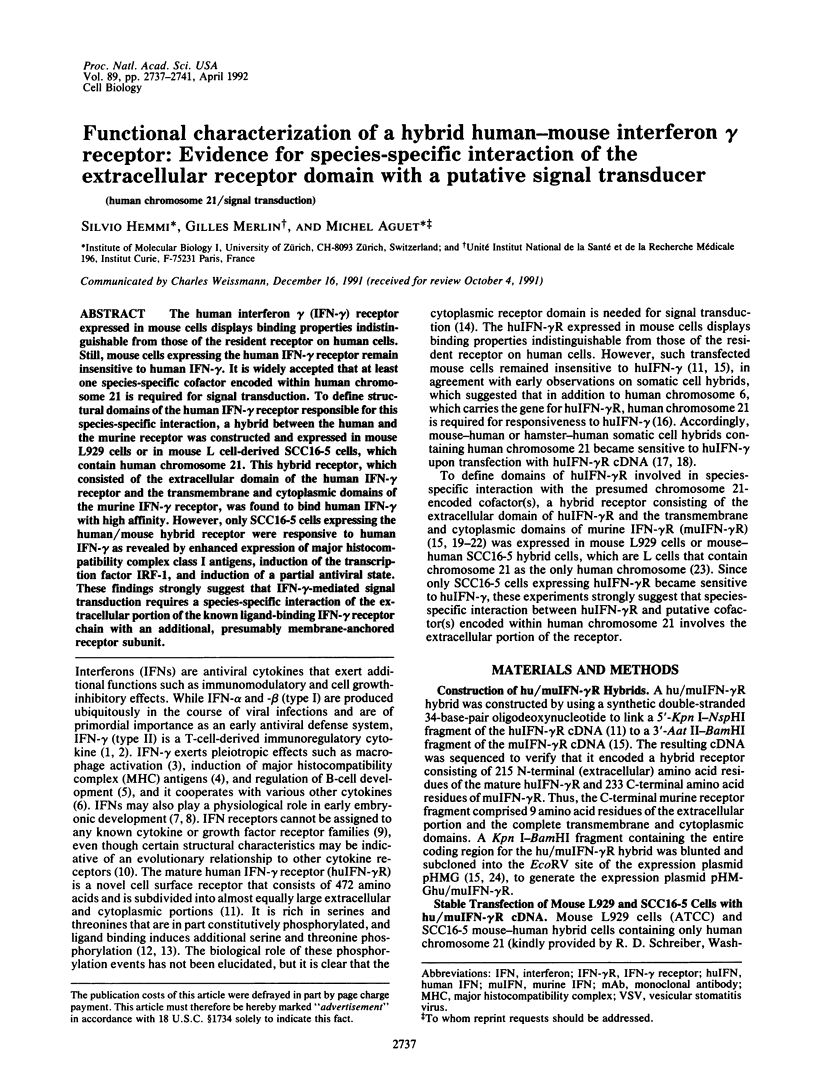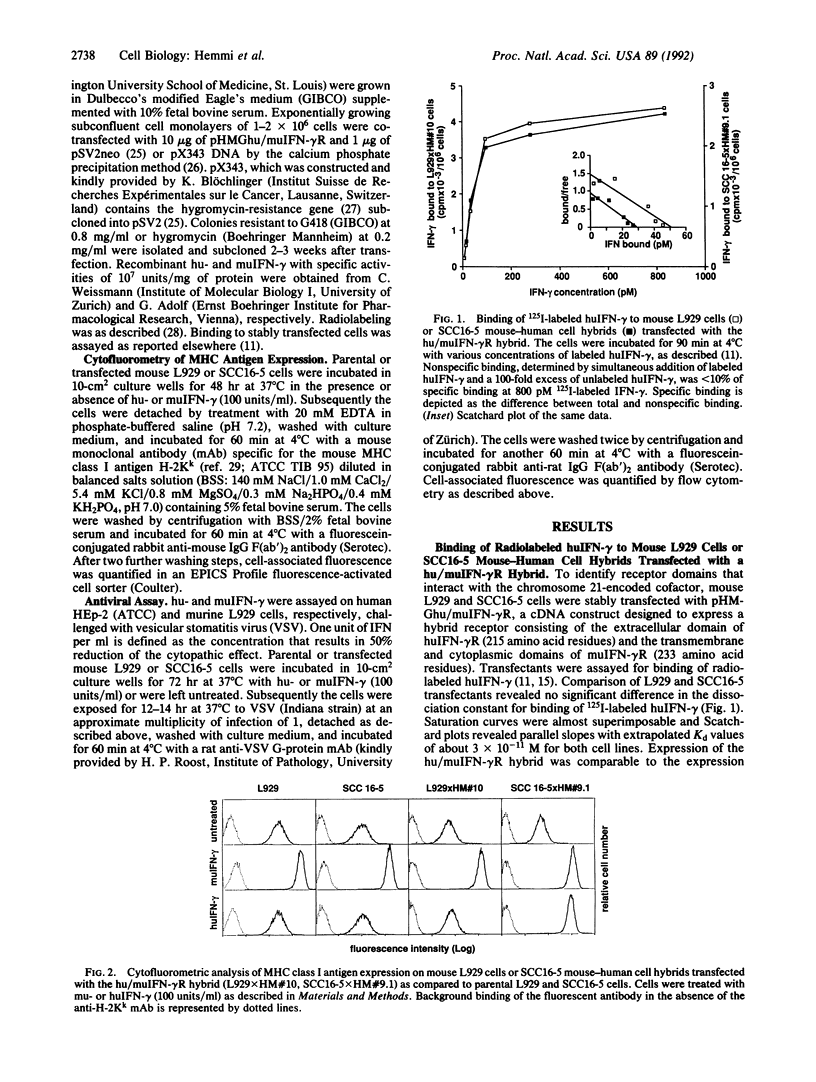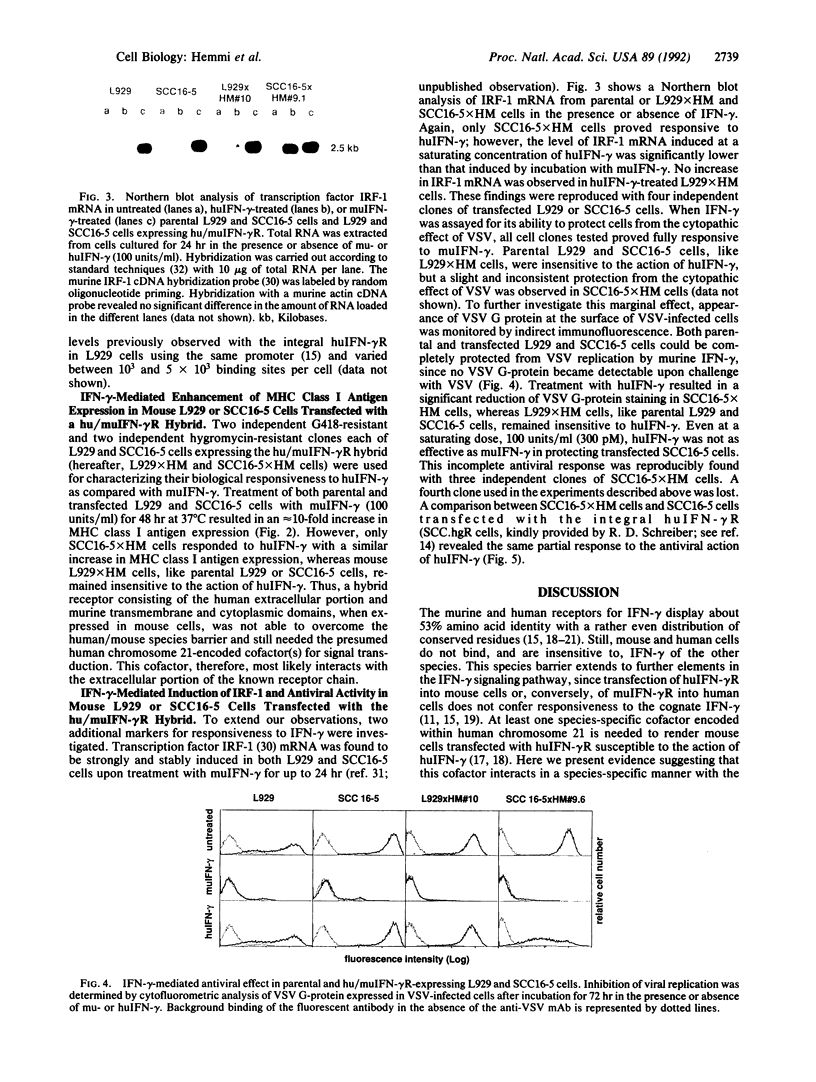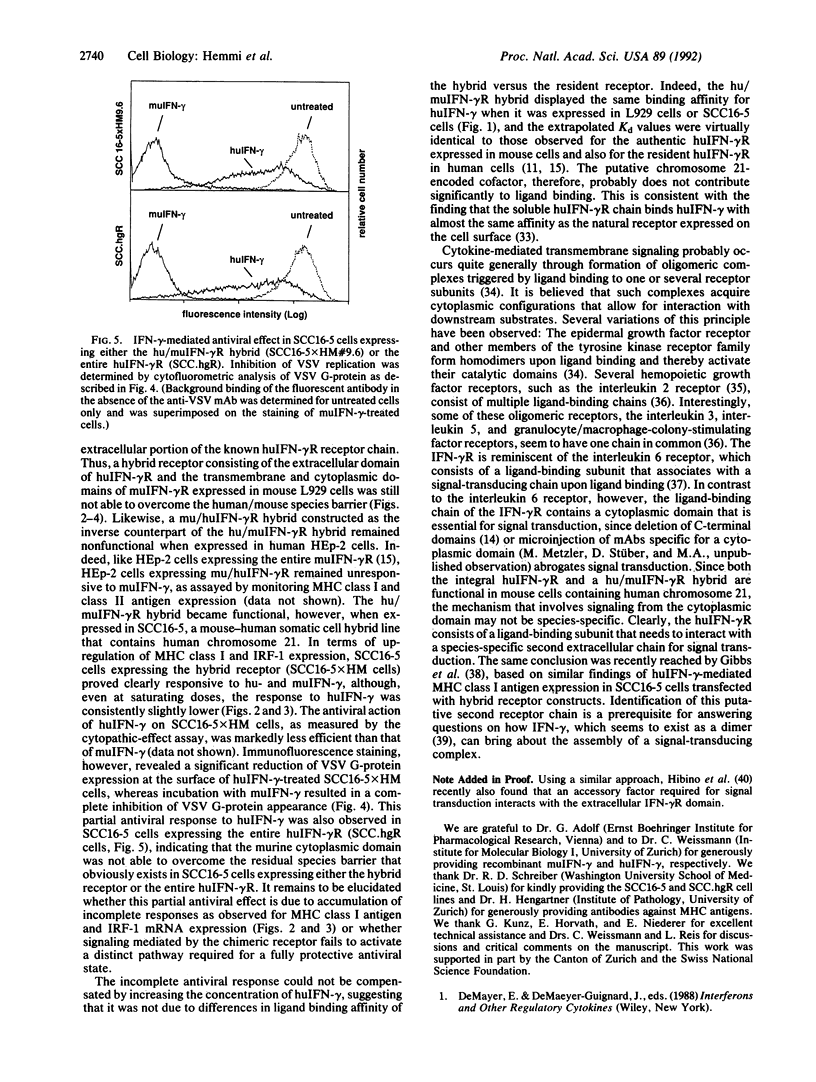Abstract
The human interferon gamma (IFN-gamma) receptor expressed in mouse cells displays binding properties indistinguishable from those of the resident receptor on human cells. Still, mouse cells expressing the human IFN-gamma receptor remain insensitive to human IFN-gamma. It is widely accepted that at least one species-specific cofactor encoded within human chromosome 21 is required for signal transduction. To define structural domains of the human IFN-gamma receptor responsible for this species-specific interaction, a hybrid between the human and the murine receptor was constructed and expressed in mouse L929 cells or in mouse L cell-derived SCC16-5 cells, which contain human chromosome 21. This hybrid receptor, which consisted of the extracellular domain of the human IFN-gamma receptor and the transmembrane and cytoplasmic domains of the murine IFN-gamma receptor, was found to bind human IFN-gamma with high affinity. However, only SCC16-5 cells expressing the human/mouse hybrid receptor were responsive to human IFN-gamma as revealed by enhanced expression of major histocompatibility complex class I antigens, induction of the transcription factor IRF-1, and induction of a partial antiviral state. These findings strongly suggest that IFN-gamma-mediated signal transduction requires a species-specific interaction of the extracellular portion of the known ligand-binding IFN-gamma receptor chain with an additional, presumably membrane-anchored receptor subunit.
Full text
PDF




Images in this article
Selected References
These references are in PubMed. This may not be the complete list of references from this article.
- Aguet M., Dembić Z., Merlin G. Molecular cloning and expression of the human interferon-gamma receptor. Cell. 1988 Oct 21;55(2):273–280. doi: 10.1016/0092-8674(88)90050-5. [DOI] [PubMed] [Google Scholar]
- Aguet M., Merlin G. Purification of human gamma interferon receptors by sequential affinity chromatography on immobilized monoclonal antireceptor antibodies and human gamma interferon. J Exp Med. 1987 Apr 1;165(4):988–999. doi: 10.1084/jem.165.4.988. [DOI] [PMC free article] [PubMed] [Google Scholar]
- Aguet M. The interferon-gamma receptor: a comparison with other cytokine receptors. J Interferon Res. 1990 Dec;10(6):551–558. doi: 10.1089/jir.1990.10.551. [DOI] [PubMed] [Google Scholar]
- Bazan J. F. Haemopoietic receptors and helical cytokines. Immunol Today. 1990 Oct;11(10):350–354. doi: 10.1016/0167-5699(90)90139-z. [DOI] [PubMed] [Google Scholar]
- Cofano F., Moore S. K., Tanaka S., Yuhki N., Landolfo S., Appella E. Affinity purification, peptide analysis, and cDNA sequence of the mouse interferon gamma receptor. J Biol Chem. 1990 Mar 5;265(7):4064–4071. [PubMed] [Google Scholar]
- Cross J. C., Roberts R. M. Constitutive and trophoblast-specific expression of a class of bovine interferon genes. Proc Natl Acad Sci U S A. 1991 May 1;88(9):3817–3821. doi: 10.1073/pnas.88.9.3817. [DOI] [PMC free article] [PubMed] [Google Scholar]
- Ealick S. E., Cook W. J., Vijay-Kumar S., Carson M., Nagabhushan T. L., Trotta P. P., Bugg C. E. Three-dimensional structure of recombinant human interferon-gamma. Science. 1991 May 3;252(5006):698–702. doi: 10.1126/science.1902591. [DOI] [PubMed] [Google Scholar]
- Farrar M. A., Fernandez-Luna J., Schreiber R. D. Identification of two regions within the cytoplasmic domain of the human interferon-gamma receptor required for function. J Biol Chem. 1991 Oct 15;266(29):19626–19635. [PubMed] [Google Scholar]
- Finkelman F. D., Holmes J., Katona I. M., Urban J. F., Jr, Beckmann M. P., Park L. S., Schooley K. A., Coffman R. L., Mosmann T. R., Paul W. E. Lymphokine control of in vivo immunoglobulin isotype selection. Annu Rev Immunol. 1990;8:303–333. doi: 10.1146/annurev.iy.08.040190.001511. [DOI] [PubMed] [Google Scholar]
- Fischer T., Rehm A., Aguet M., Pfizenmaier K. Human chromosome 21 is necessary and sufficient to confer human IFN gamma responsiveness to somatic cell hybrids expressing the cloned human IFN gamma receptor gene. Cytokine. 1990 May;2(3):157–161. doi: 10.1016/1043-4666(90)90010-q. [DOI] [PubMed] [Google Scholar]
- Fountoulakis M., Juranville J. F., Stüber D., Weibel E. K., Garotta G. Purification and biochemical characterization of a soluble human interferon gamma receptor expressed in Escherichia coli. J Biol Chem. 1990 Aug 5;265(22):13268–13275. [PubMed] [Google Scholar]
- Gautier C., Mehtali M., Lathe R. A ubiquitous mammalian expression vector, pHMG, based on a housekeeping gene promoter. Nucleic Acids Res. 1989 Oct 25;17(20):8389–8389. doi: 10.1093/nar/17.20.8389. [DOI] [PMC free article] [PubMed] [Google Scholar]
- Gibbs V. C., Williams S. R., Gray P. W., Schreiber R. D., Pennica D., Rice G., Goeddel D. V. The extracellular domain of the human interferon gamma receptor interacts with a species-specific signal transducer. Mol Cell Biol. 1991 Dec;11(12):5860–5866. doi: 10.1128/mcb.11.12.5860. [DOI] [PMC free article] [PubMed] [Google Scholar]
- Graham F. L., van der Eb A. J. A new technique for the assay of infectivity of human adenovirus 5 DNA. Virology. 1973 Apr;52(2):456–467. doi: 10.1016/0042-6822(73)90341-3. [DOI] [PubMed] [Google Scholar]
- Gray P. W., Leong S., Fennie E. H., Farrar M. A., Pingel J. T., Fernandez-Luna J., Schreiber R. D. Cloning and expression of the cDNA for the murine interferon gamma receptor. Proc Natl Acad Sci U S A. 1989 Nov;86(21):8497–8501. doi: 10.1073/pnas.86.21.8497. [DOI] [PMC free article] [PubMed] [Google Scholar]
- Gritz L., Davies J. Plasmid-encoded hygromycin B resistance: the sequence of hygromycin B phosphotransferase gene and its expression in Escherichia coli and Saccharomyces cerevisiae. Gene. 1983 Nov;25(2-3):179–188. doi: 10.1016/0378-1119(83)90223-8. [DOI] [PubMed] [Google Scholar]
- Hatakeyama M., Tsudo M., Minamoto S., Kono T., Doi T., Miyata T., Miyasaka M., Taniguchi T. Interleukin-2 receptor beta chain gene: generation of three receptor forms by cloned human alpha and beta chain cDNA's. Science. 1989 May 5;244(4904):551–556. doi: 10.1126/science.2785715. [DOI] [PubMed] [Google Scholar]
- Hemmi S., Peghini P., Metzler M., Merlin G., Dembic Z., Aguet M. Cloning of murine interferon gamma receptor cDNA: expression in human cells mediates high-affinity binding but is not sufficient to confer sensitivity to murine interferon gamma. Proc Natl Acad Sci U S A. 1989 Dec;86(24):9901–9905. doi: 10.1073/pnas.86.24.9901. [DOI] [PMC free article] [PubMed] [Google Scholar]
- Hershey G. K., McCourt D. W., Schreiber R. D. Ligand-induced phosphorylation of the human interferon-gamma receptor. Dependence on the presence of a functionally active receptor. J Biol Chem. 1990 Oct 15;265(29):17868–17875. [PubMed] [Google Scholar]
- Honjo T. Shared partners in receptors. Curr Biol. 1991 Aug;1(4):201–203. doi: 10.1016/0960-9822(91)90055-2. [DOI] [PubMed] [Google Scholar]
- Janssen J. W., Collard J. G., Tulp A., Cox D., Millington-Ward A., Pearson P. Construction and analysis of an EMBL-3 phage library containing partially digested human chromosome 21-specific DNA inserts (15-20 kb). Cytometry. 1986 Sep;7(5):411–417. doi: 10.1002/cyto.990070504. [DOI] [PubMed] [Google Scholar]
- Jung V., Jones C., Kumar C. S., Stefanos S., O'Connell S., Pestka S. Expression and reconstitution of a biologically active human interferon-gamma receptor in hamster cells. J Biol Chem. 1990 Feb 5;265(4):1827–1830. [PubMed] [Google Scholar]
- Jung V., Rashidbaigi A., Jones C., Tischfield J. A., Shows T. B., Pestka S. Human chromosomes 6 and 21 are required for sensitivity to human interferon gamma. Proc Natl Acad Sci U S A. 1987 Jun;84(12):4151–4155. doi: 10.1073/pnas.84.12.4151. [DOI] [PMC free article] [PubMed] [Google Scholar]
- Kumar C. S., Muthukumaran G., Frost L. J., Noe M., Ahn Y. H., Mariano T. M., Pestka S. Molecular characterization of the murine interferon gamma receptor cDNA. J Biol Chem. 1989 Oct 25;264(30):17939–17946. [PubMed] [Google Scholar]
- Lefèvre F., Martinat-Botté F., Guillomot M., Zouari K., Charley B., La Bonnardière C. Interferon-gamma gene and protein are spontaneously expressed by the porcine trophectoderm early in gestation. Eur J Immunol. 1990 Nov;20(11):2485–2490. doi: 10.1002/eji.1830201119. [DOI] [PubMed] [Google Scholar]
- Levy D. E., Lew D. J., Decker T., Kessler D. S., Darnell J. E., Jr Synergistic interaction between interferon-alpha and interferon-gamma through induced synthesis of one subunit of the transcription factor ISGF3. EMBO J. 1990 Apr;9(4):1105–1111. doi: 10.1002/j.1460-2075.1990.tb08216.x. [DOI] [PMC free article] [PubMed] [Google Scholar]
- Mao C., Merlin G., Ballotti R., Metzler M., Aguet M. Rapid increase of the human IFN-gamma receptor phosphorylation in response to human IFN-gamma and phorbol myristate acetate. Involvement of different serine/threonine kinases. J Immunol. 1990 Dec 15;145(12):4257–4264. [PubMed] [Google Scholar]
- Miyamoto M., Fujita T., Kimura Y., Maruyama M., Harada H., Sudo Y., Miyata T., Taniguchi T. Regulated expression of a gene encoding a nuclear factor, IRF-1, that specifically binds to IFN-beta gene regulatory elements. Cell. 1988 Sep 9;54(6):903–913. doi: 10.1016/s0092-8674(88)91307-4. [DOI] [PubMed] [Google Scholar]
- Munro S., Maniatis T. Expression cloning of the murine interferon gamma receptor cDNA. Proc Natl Acad Sci U S A. 1989 Dec;86(23):9248–9252. doi: 10.1073/pnas.86.23.9248. [DOI] [PMC free article] [PubMed] [Google Scholar]
- Nacy C. A., Meltzer M. S. T-cell-mediated activation of macrophages. Curr Opin Immunol. 1991 Jun;3(3):330–335. doi: 10.1016/0952-7915(91)90033-w. [DOI] [PubMed] [Google Scholar]
- O'Garra A. Interleukins and the immune system 2. Lancet. 1989 May 6;1(8645):1003–1005. doi: 10.1016/s0140-6736(89)92640-8. [DOI] [PubMed] [Google Scholar]
- Oi V. T., Jones P. P., Goding J. W., Herzenberg L. A., Herzenberg L. A. Properties of monoclonal antibodies to mouse Ig allotypes, H-2, and Ia antigens. Curr Top Microbiol Immunol. 1978;81:115–120. doi: 10.1007/978-3-642-67448-8_18. [DOI] [PubMed] [Google Scholar]
- Southern P. J., Berg P. Transformation of mammalian cells to antibiotic resistance with a bacterial gene under control of the SV40 early region promoter. J Mol Appl Genet. 1982;1(4):327–341. [PubMed] [Google Scholar]
- Taga T., Hibi M., Hirata Y., Yamasaki K., Yasukawa K., Matsuda T., Hirano T., Kishimoto T. Interleukin-6 triggers the association of its receptor with a possible signal transducer, gp130. Cell. 1989 Aug 11;58(3):573–581. doi: 10.1016/0092-8674(89)90438-8. [DOI] [PubMed] [Google Scholar]
- Ullrich A., Schlessinger J. Signal transduction by receptors with tyrosine kinase activity. Cell. 1990 Apr 20;61(2):203–212. doi: 10.1016/0092-8674(90)90801-k. [DOI] [PubMed] [Google Scholar]



